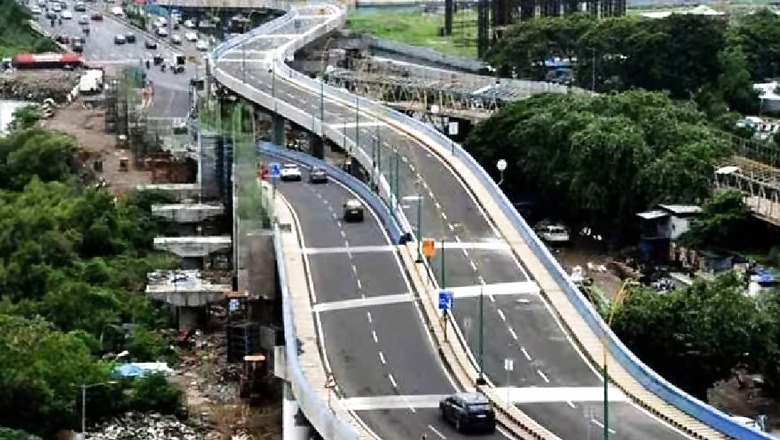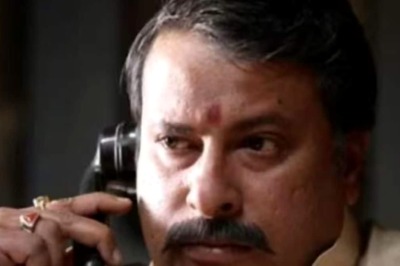
views
India, the world’s largest democracy and a rising economic powerhouse, is embarking on a massive infrastructure overhaul. The ambitious plan by the Ministry of Road Transport and Highways aims to transform the nation’s highway network, paving the way for a more prosperous future.
The centrepiece of this initiative is the conversion of all existing single-lane national highways into double lanes. This seemingly simple upgrade carries significant weight. Improved roads not only expedite the movement of people and goods but also unlock economic opportunities in remote areas. In a country with a population of 1.4 billion, a smoother flow of traffic translates to faster delivery of essential supplies, reduced travel times, and a significant boost to domestic trade.
This infrastructure push aligns perfectly with the government’s vision of “Viksit Bharat” – a developed India. It recognises that robust infrastructure is the backbone of a thriving economy. Moreover, the focus on high-speed access-controlled highways signifies India’s aspirations to join the league of nations with world-class road networks. By 2037, India aims to create a system that enhances efficiency, reduces logistics costs, and propels the country towards its ambitious goal of becoming a developed nation by 2047.
The Double-Lane Revolution
India’s ambitious plan to convert all single-lane national highways into double lanes with paved shoulders marks a significant step towards establishing a minimum standard for its national highway network. This seemingly basic upgrade will have far-reaching consequences. Double lanes will ensure greater uniformity, improve traffic flow and safety, and significantly enhance the capacity of these crucial arteries to handle the movement of people and goods.
It’s important to note that road width is ultimately determined by traffic volume (both current and projected). Therefore, only highways with sufficient projected traffic will be prioritised for conversion to national highways. Currently, over 90% of the network already boasts two lanes or more, highlighting the significant progress made in recent years.
The remaining single-lane highways will be evaluated for expansion. Wherever feasible, they will be broadened to double lanes with paved shoulders. However, officials acknowledge that geographic constraints or ecological concerns may necessitate retaining single lanes in a limited number of stretches. The goal is to reduce these single-lane sections to less than 5% of the total highway network in the coming years.
This dramatic shift is evident in the declining number of single-lane highways. Since 2014, their share of the network has shrunk from 30% to just 10%, while the proportion of four-lane or more highways has nearly doubled, jumping from 20% to 32%. This rapid transformation underscores India’s commitment to building a modern and efficient highway infrastructure for its future.
Building at Lightning Speed: Towards a World-Class Network
India’s highway construction has witnessed a remarkable acceleration in recent years. The average annual construction has more than doubled, jumping from 4,174 km pre-2014 to an impressive 9,304 km between 2014 and 2023. This momentum continues in the current year, with the Ministry targeting a record-breaking 12,500 km of national highways – translating to a staggering 35 km constructed every day.
Beyond sheer quantity, the focus has shifted to quality. High-speed access-controlled corridors are a prime example. Their length has skyrocketed from a mere 550 km in 2014 to a significant 4,000 km today, signifying a near seven-fold increase. This financial year promises to see the largest-ever construction of both four-lane highways and high-speed access-controlled roads.
This rapid progress is further underscored by the tripling of contract awards – from an average of 3,952 km pre-2014 to a substantial 11,287 km annually between 2014 and 2023. The current year is expected to witness awards for approximately 9,000 km. In fact, the past four years alone (FY 2019-20 to FY 2022-23) have seen a staggering 45,019 km of national highways awarded – an average of over 11,000 km annually.
This surge in activity is mirrored by a significant increase in capital expenditure, rising from Rs 28,234 crore in FY 2009-10 to a robust Rs 2,50,226 crore in FY 2022-23.
A Well-Oiled Machine: Efficiency and Innovation
India’s success hinges on a well-developed programme encompassing every stage of highway development, from initial planning (DPR) to construction, operation, and maintenance. The Ministry operates with a lean and agile structure, ensuring sufficient resources and efficient project execution. A robust contracting system has also been established, with the number of contractors nearly doubling in recent years due to government initiatives that foster healthy competition.
This focus on innovation extends to welcoming new designs, construction methods, and technologies. Furthermore, tenders are designed to prioritise achieving specific outcomes, ensuring the highest quality infrastructure for India’s future.
The Road Ahead: Ambitious Targets and Strategic Execution
India’s highway revolution isn’t just about laying asphalt; it’s about building a foundation for a thriving future.
This ambitious journey hinges on two critical initiatives – the ongoing Bharatmala Pariyojana and the long-range Vision 2047 Master Plan. Both programmes are fundamental to realising the Prime Minister’s vision of a “Viksit Bharat” – a fully developed India – by 2047.
Building on a Strong Foundation: Legacy of Bharatmala
Launched in 2015, Bharatmala Pariyojana has been a game-changer for India’s highway network. This “scientifically designed” programme goes beyond mere road construction. It delves into the heart of India’s economic activity, meticulously analysing traffic movement patterns and production-consumption centres through e-way bill data. By leveraging this data, Bharatmala identifies crucial freight corridors, ensuring resources are directed where they can have the most significant impact.
The programme’s success speaks volumes. As of January 2024, over 26,400 km of highways have been awarded for construction under Bharatmala, with nearly 16,000 km already completed. Completed projects like the Ambala-Kotputli corridor and sections of the prestigious Delhi-Mumbai Expressway stand as testaments to Bharatmala’s effectiveness. These projects not only improve connectivity but also serve as stepping stones for the even more ambitious Vision 2047 Master Plan.
Vision 2047: A High-Speed Future Beckons
The Ministry of Road Transport and Highways (MoRTH) has taken a bold step with the Vision 2047 Master Plan. This program envisions a future woven with high-speed access-controlled corridors stretching across a staggering 50,000 km by 2047. Imagine a nation where expressways are readily accessible from most locations, revolutionising the movement of people and goods across vast distances. Travel times will plummet, economic activity will surge, and India will be firmly positioned as a leader in global logistics.
However, achieving this ambitious goal requires meticulous planning and strategic execution. The “PM Gati Shakti” framework plays a crucial role here. This framework acts as a powerful tool, utilising e-way bill and toll data to pinpoint congestion hotspots with pinpoint accuracy. This data-driven approach ensures that new expressways are strategically placed – not just connecting major cities, but also addressing existing bottlenecks and optimising the entire network for seamless movement.
Collaboration is Key
Vision 2047 transcends traditional infrastructure projects. The “whole-of-government” approach ensures that various ministries work in concert, fostering efficient execution and minimising project overlap.
Imagine a scenario where departments responsible for land acquisition, environmental clearances, and utility relocation work hand-in-hand with MoRTH, streamlining the entire process. This collaborative spirit is crucial for turning the ambitious vision into a tangible reality.
The Road Ahead
The road ahead is undoubtedly ambitious, but the potential benefits are colossal. By strategically building upon Bharatmala’s success and relentlessly pursuing the high-speed vision of 2047, India is poised for a paradigm shift. Reduced logistics costs will translate into a more competitive economy, attracting new investments and propelling India’s growth trajectory. Additionally, faster movement of goods will benefit both producers and consumers, stimulating economic activity across the nation.
However, the journey won’t be without challenges. Funding such a large-scale project will require innovative financial models and potentially, private sector participation. Additionally, ensuring environmental sustainability and social responsibility during construction will be paramount.
The success of India’s highway revolution hinges on a well-defined strategy grounded in data, collaboration, and a commitment to innovation. By tackling these challenges head-on and harnessing the potential of Bharatmala and Vision 2047, India can pave the way for a brighter, more prosperous future, not just for itself, but for the entire region.
A Highway to Transformation
India’s highway revolution transcends mere asphalt. It’s a strategic leapfrog towards a transformed nation. This ambitious infrastructure push, led by MoRTH, promises to reshape India’s economic landscape with positive ripple effects reaching far beyond its borders.
Domestic Engine: Reduced logistics costs, a dream for Indian businesses, will be a reality with the double-lane network and high-speed corridors. Faster movement of goods will fuel a more competitive economy, attracting investments and propelling domestic trade. Improved rural connectivity will empower remote communities and open new markets for agricultural products.
Regional Catalyst: India’s transformation will be contagious. Improved road connectivity will streamline cross-border trade with neighbouring countries, boosting trade volumes and fostering closer economic integration for a region-wide win-win.
Global Leader: India’s ambitious highway revolution serves as a beacon of progress for developing nations. By overcoming challenges and successfully implementing large-scale infrastructure projects, India demonstrates its commitment to sustainable development and economic growth, inspiring others to embark on similar transformations.
Funding, environment, and social responsibility remain hurdles, but with a clear vision, strategic planning, and collaborative execution, India is well-positioned to turn its highway revolution into reality. The world watches with keen interest, eager to witness the rise of a new economic powerhouse and a leader in infrastructure development.
This ambitious journey holds the potential to not only reshape India’s future but also serve as a blueprint for progress, inspiring a wave of development across the globe. As India embarks on this transformative path, one thing is certain: the road ahead is bright.


















Comments
0 comment